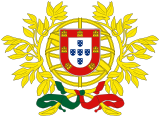
Back Município (Portugal) German Municipio de Portugal Spanish Munisipalitas di Portugal ID Municipalities of Portugal SIMPLE Portugals kommuner Swedish Portekiz'in belediyeleri Turkish پرتگال کی بلدیات Urdu Município Vietnamese 市镇 (葡萄牙) Chinese
| Municipality | |
|---|---|
| |
 | |
| Category | 2nd-level administrative division |
| Location | Portugal |
| Found in | Administrative region Autonomous region |
| Created | |
| Number | 308 |
| Populations | 435–567,131 |
| Areas | 7.9–1,720.6 km2 |
| Government | |
| Subdivisions |
|
 |
|---|
| Constitution |
The municipality (Portuguese: município or concelho) is the second-level administrative subdivision of Portugal, as defined by the 1976 Constitution.[1]
As a general rule, each municipality is further subdivided into parishes (freguesias); the municipalities in the north of the country usually have a higher number of parishes. Six municipalities are composed of only one parish, and Barcelos, with 61 parishes, has the most. Corvo is, by law, the only municipality with no parishes.
Since the creation of a democratic local administration, in 1976, the Portuguese municipalities have been ruled by a system composed of an executive body (the municipal chamber) and a deliberative body (the municipal assembly). The municipal chamber is the executive body and is composed of the president of the municipality and a number of councillors proportional to the municipality's population. The municipal assembly is composed of the presidents of all the parishes that compose the municipality, as well as by a number of directly elected deputies, at least equal to the number of parish presidents plus one. Both bodies are elected for four years.[1]
Portugal has an entirely separate system of ceremonial cities and towns. Cities and towns are located in municipalities but often do not have the same boundaries, even they are continuously built up. There are around twice as many cities and towns as there are municipalities.
- ^ a b "7th Constitutional Revision" (PDF). Assembly of the Republic (Portugal). Archived from the original (PDF) on 22 October 2014. Retrieved 13 August 2014.